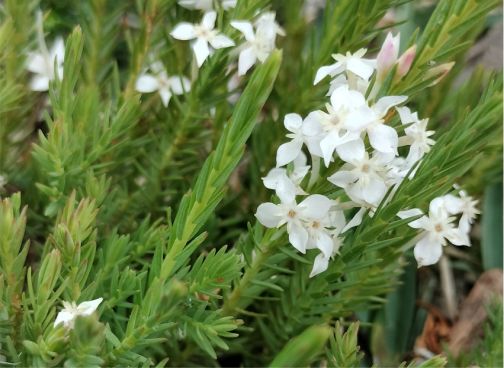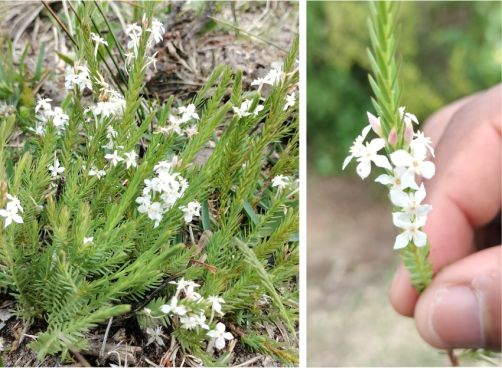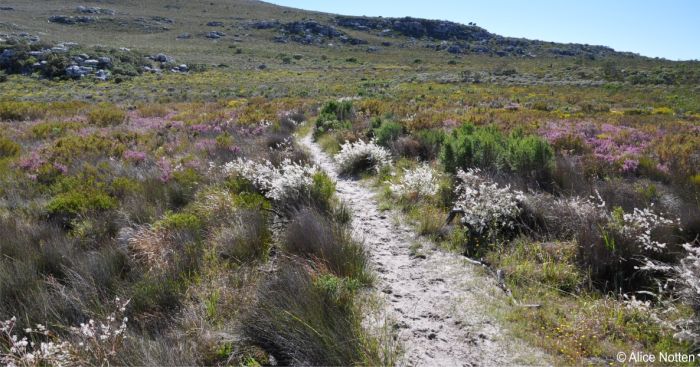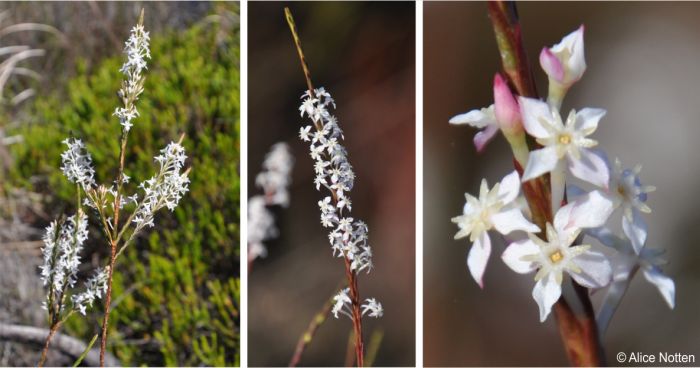Struthiola dodecandra
Struthiola dodecandra (L.) Druce
Family: Thymelaeaceae
Common names: sweet gonna, pink featherhead (Eng.); soetgonna, katstertjie, heuningblommetjie (Afr.)
Introduction
Struthiola dodecandra is an erect shrublet with white or pink, night-scented flowers arranged in long spikes at the tips of the slender stems, which makes it attractive all year round.

Description
Description
Struthiola dodecandra is an erect, spindly shrublet about 800 mm high with lax, squared (tetragonal) branches. Leaves are opposite, lanced-shaped to narrowly elliptic, with a pointed tip (acute), smooth or faintly ribbed below. It produces white or pink flowers in the axils of the leaves (axillary). Each flower with 8 narrowly ovoid petal-like scales at the mouth, a hairless tube 8-26 mm long. and 4 anthers. Flowering occurs all year round, from January to December. The flowers have no scent during the day, but after sunset, they have a strong, sweet scent.

Conservation Status
Status
According to According to Red List of South African Plants, Struthiola dodecandra is Least Concern (LC), the last assessment that was done back in 2005 shows the population of S. dodecandra to be stable in the wild.
Distribution and habitat
Distribution description
Struthiola dodecandra grows on damp flats and lower slopes in the Western Cape of South Africa, from the Cape Peninsula to Bredasdorp and Knysna.

Derivation of name and historical aspects
History
The name of the genus Struthiola is derived from the Greek word for a small bird or sparrow, referring to the tiny seed resembling a sparrow’s beak. The species name dodecandra is also derived from Greek, dodeka meaning ‘having 12’ and andra the male part of the flower, i.e. ‘stamens’; which may refer to the 4 stamens plus the 8 scales. The common name soetgonna means ‘sweet slender shrub’, it fuses words from both Afrikaans (soet) and Kora, a Khoikoi language, (gonna). Soet, meaning ‘sweet’, refers to the strong scent of the flowers, that can easily be detected at night. The name gonna refers to plants with tough, fibrous bark that Khoikhoi people used to make string and twine.
Struthiola dodecandra is a species in the family Thymelaeaceae, native to South Africa. The genus Struthiola comprises of approximately 40 species, most of which occur in the Western Cape with ±25 species endemic to the Fynbos Biome.
Ecology
Ecology
Struthiola dodecandra is an all year round flowering plant that is pollinated by moths. The moths are attracted by the strong, sweet scent produced by the flowers, and their pale pink orwhite colour makes them more noticeable at night time. Their strong scent can easily be detected when the air is warm.

Uses
Use
The fibrous bark, which can be peeled off the stems in long strips, was used to make rope and string by the Khoikhoi and San people, like many other plants in the Thymelaeaceae. In the garden Struthiola dodecandra can be planted in full sun in moist sand and clayish soils, perfect for grey water or wetland surroundings.
Growing Struthiola dodecandra
Grow
Struthiola dodecandra can be propagated both by seeds and cuttings but the best method is cuttings. Collect cuttings from healthy mother stock in autumn or spring, plant in well-aerated growing medium and place on a heated bench, this will help speed up rooting and reduce the number of weeks needed for rooting. After about 6 weeks, transplant the rooted cuttings into planting bags and care for them until they are ready and strong enough to be planted out into the garden during winter months. Plant them in full sun, in moist soil or in a wetland area.
Propagation by seeds is challenging because the seeds disperse quickly. To harvest seeds, the plants should be monitored and the flowering stems carefully covered with mesh bags that will catch the seeds as they disperse and they can thus be collected when ready. Sow seeds in the autumn months, preferably April, and treat the seeds with smoke to ensure a better germination rate.
References
- Fernkloof Nature Reserve, Struthiola dodecandra. https://www.fernkloof.org.za/index.php/all-plants/plant-families/item/struthiola-dodecandra. Accessed 11/12/2023.
- FynbosLIFE. Struthiola dodecandra. https://www.fynboslife.com/plantprofile/struthiola-dodecandra/. Accessed 11/12/2023.
- Manning, J. & Goldblatt, P. 2012. Plants of the Greater Cape Floristic Region 1: the Core Cape Flora. Strelitzia 29. South African National Biodiversity Institute, Pretoria.
- Latti, I. n.d. Strutiola dodecandra. Operation Wildflower. Online. https://www.operationwildflower.org.za/index.php/albums/genera-m-z/struthiola/struthiola-dodecandra-judd-4-4620.
- Makholela, T. 2006. Struthiola ciliata (L.) Lam. (Thymelaeaceae). PlantZAfrica. Online. https://pza.sanbi.org/struthiola-ciliata.
- Manning, J. 2007. Field guide to Fynbos. Struik Publishers, Cape Town.
- Raimondo, D., Von Staden, L., Foden, W., Victor, J.E., Helme, N.A., Turner, R.C., Kamundi, D.A. & Manyama, P.A. (eds) 2009. Red list of South African plants. Strelitzia 25. South African National Biodiversity Institute, Pretoria.
- Vlok, J. & Schutte-Vlok, A.L. 2010. Plants of the Klein Karoo. Umdaus Press, Hatfield.
- Xaba, P. 2007. Struthiola argentea Lehm. (Thymelaeceae). PlantZAafrica. Online. https://pza.sanbi.org/struthiola-argentea.
Credits
Caroline Marima
Harold Porter National Botanical Garden
January 2024
Plant Attributes:
Plant Type: Shrub
SA Distribution: Western Cape
Soil type: Sandy, Loam
Flowering season: Sporadic/All year
PH: Acid
Flower colour: White, Pink
Aspect: Full Sun
Gardening skill: Average
Special Features:
Horticultural zones







Rate this article
Article well written and informative
Rate this plant
Is this an interesting plant?
Login to add your Comment
Back to topNot registered yet? Click here to register.